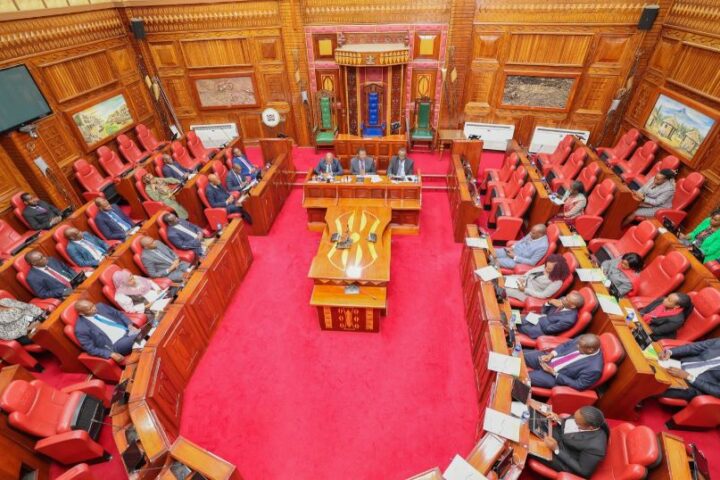Activist Okiya Omtatah Okoiti, famous for chaining himself during anti-corruption demonstrations in Nairobi is proposing radical changes in Kenya’s electoral system, particularly at the presidential level.
The activist brings forward Mutahi Ngunyi’s tyranny of numbers theory, which was proved right by the election results, as a dangerous trend, where two communities determined who would lead Kenya, against a total of 42 communities. In the report titled ‘Moving from tyranny to safety of numbers’, Omtatah borrows heavily from American electoral college system, where the popular vote is not enough to produce a president. Each state is allocated a certain number of votes at the electoral college, and whoever wins the popular vote in that state takes its electoral college votes.
Omtatah’s proposal, should it even get to parliament, will surely bring endless debates on the number of votes each county should be allocated, and what criteria should be used.
Here’s Omtatah’s take.. , but the problem is the fact he proposes it as Pro-Raila. Should he bring it forth as a neutral party, maybe he can be taken more seriously.
Moving from tyranny to safety of numbers
————————————————Kenya is a multi-ethnic state, composed of 42 officially recognised tribes. The 2009 census figures give the ethnic composition as follows (out of a total population of 38.6 million): Kikuyu 17%, Luhya 14%, Kalenjin 13%, Luo 10%, Kamba 10%, Kisii 6%, Mijikenda 5%, Meru 4%, Turkana 2.5%, and Maasai 2.1%. About 9% of the population consist of smaller groups below 1% each, and Non-African groups (Arabs, Indians and Europeans) are estimated to total to about 1%.
Ever since Kenya’s independence in 1963, Kenyan politics have been characterized by ethnic tensions and rivalry between the larger groups, escalating into the 2007–2008 post-election violence that nearly plunged the country into a civil war.
There is need to raise one million signatures as required under the popular initiative (article 257) to amend article 136 of the constitution to provide for the election of the president through a county based electoral system as opposed to the current one-person-one-vote system which has been reduced to a mere census of tribal numbers.
The beauty of Kenya’s diversity is such that there is no majority tribe. There are large tribes but none is more than 50% of the population. For example, its largest ethnic group, the Kikuyu, make up for less than a fifth of the total population. In reality, therefore, Kenya has a safety of numbers, and not a tyranny of numbers, among its ethnic groups. However, to exploit this reality, Kenya must institute a presidential electoral system where all ethnic groups, large and small, feel safe and important in the prosecution of national affairs, especially as embodied in the election of the President and the Deputy President, who are symbols both of national consensus and of the unity of the Republic.
The system must move the country away from the current state of affairs where large tribes tyrannise smaller ones during elections, and where the main criteria for occupying the Presidency is the numerical size of the ethnic blocks backing a candidate. The system must boost the process of devolving power from Nairobi, an act designed to improve local governance and to reduce marginalization and the risk of conflict between communities.
Such as system is only possible where the President and the Deputy President are not elected directly in a popular vote nationally. Instead, they are elected indirectly by popular vote on a county-by-county basis.
The United States of America elects its politically powerful president via an electoral college designed to ensure the election of the president through a popular vote and to protect the interests of the states. The founders of the USA wanted each state to have a voice in the election of the president and, therefore, even small states have political influence nationally. The US Constitution specifies that the president and vice president be chosen through the votes cast by electors chosen by the states, rather than by a direct popular vote. Hence, the President and Vice President are not elected directly by the voters. Instead, they are elected indirectly by “electors” who are elected by popular vote on a state-by-state basis. And a candidate can become president without having obtained the highest number of votes nationally in the sole or final round of popular voting.
The county electoral system is a block, or weighed, voting system that is designed to give more power to the counties with more votes, but allows for small counties to swing an election. Under this system, each county is assigned a specific number of votes that is proportional to its population, so that each county’s power is representative of its population. So, while winning the popular vote may not ensure a candidate’s victory, a candidate must gain popular support of a particular county to win the votes in that county.
Each county is apportioned electoral votes equal to the number of its elected Members of National Assembly plus one elected Senator. Hence, there would be 337 electoral votes, being 290 Members of the National Assembly and 47 Senators elected into Parliament. The county electoral votes are taken on a “winner-take-all” basis. That is, all electoral votes in a county are given to the winning presidential candidate. To be elected President, one must get at least 169 votes, being 50% + 1 of the electoral votes. The goal of any candidate would be to put together the right combination of counties that will give him or her 169 electoral votes.
Should none of the candidates win 169 electoral votes a runoff between the top two candidates will be conducted.
Under the system, and using IEBC figures, results of the 2013 elections would be:
Raila 197 votes
Uhuru 134 votes
Mudavadi 6 votes
Muite 0 Votes
Dida 0 Votes
Karua 0 Votes
Kiyapi 0 Votes
Kenneth 0 Votes
The current distribution of Electoral Votes per county would be as follows:
Mombasa 7
Kwale 5
Kilifi 8
Tana River 4
Lamu 3
Taita Taveta 5
Garissa 7
Wajir 7
Mandera 7
Marsabit 5
Isiolo 3
Meru 10
Tharaka Nithi 4
Embu 5
Kitui 9
Machakos 9
Makueni 7
Nyandarua 6
Nyeri 7
Kirinyaga 5
Murang’a 8
Kiambu 13
Turkana 7
West Pokot 5
Samburu 4
Trans Nzoia 6
Uasin Gishu 7
Elgeyo Marakwet 5
Nandi 7
Baringo 7
Laikipia 4
Nakuru 12
Narok 7
Kajiado 6
Kericho 7
Bomet 6
Kakamega 13
Vihiga 6
Bungoma 10
Busia 8
Siaya 7
Kisumu 8
Homa Bay 9
Migori 9
Kisii 10
Nyamira 5
Nairobi 18
TOTALS 337
© nairobiwire.com







